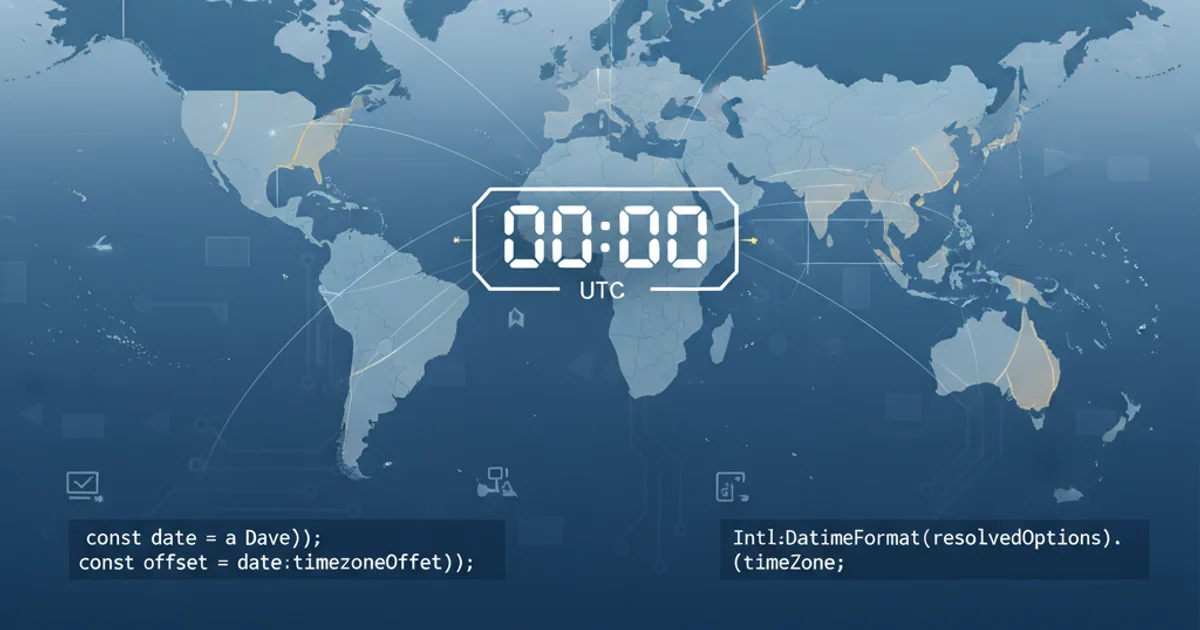Get utc offset from timezone in Javascript
Categories:
Getting UTC Offset from Timezone in JavaScript

Learn various methods to determine the UTC offset for a given timezone in JavaScript, covering native Date objects, Intl.DateTimeFormat, and external libraries.
Working with timezones in JavaScript can be notoriously tricky. While the Date object handles local time and UTC, directly obtaining the UTC offset for an arbitrary timezone string (like 'America/New_York') isn't straightforward with native methods alone. This article explores several approaches, from leveraging built-in browser APIs to using robust third-party libraries, to accurately calculate the UTC offset.
Understanding UTC Offset
The UTC offset represents the difference in hours and minutes between a specific timezone and Coordinated Universal Time (UTC). This offset can vary throughout the year due to Daylight Saving Time (DST). For example, 'America/New_York' is UTC-05:00 during standard time and UTC-04:00 during DST. It's crucial to consider a specific date when calculating the offset to account for DST changes.
flowchart TD
A[Start] --> B{"Input: Timezone String & Date"}
B --> C{Determine if DST is active for Date in Timezone}
C -- Yes --> D[Apply DST Offset]
C -- No --> E[Apply Standard Offset]
D --> F[Calculate UTC Offset]
E --> F
F --> G[Output: UTC Offset (e.g., -05:00)]
G --> H[End]Conceptual flow for determining UTC offset considering Daylight Saving Time.
Method 1: Using Intl.DateTimeFormat (Modern Browsers)
Modern JavaScript environments (browsers and Node.js with full ICU data) offer the Intl.DateTimeFormat object, which can be surprisingly useful for this task. By formatting a date in the target timezone and then comparing it to a UTC date, we can infer the offset. This method implicitly handles Daylight Saving Time.
function getUtcOffsetFromTimezone(timeZone, date = new Date()) {
const options = {
year: 'numeric',
month: 'numeric',
day: 'numeric',
hour: 'numeric',
minute: 'numeric',
second: 'numeric',
timeZoneName: 'shortOffset',
timeZone: timeZone
};
const formatter = new Intl.DateTimeFormat('en-US', options);
const parts = formatter.formatToParts(date);
let offsetString = '';
for (const part of parts) {
if (part.type === 'timeZoneName') {
offsetString = part.value;
break;
}
}
// Example offsetString: "GMT-5", "GMT+1", "UTC-04:00"
if (!offsetString) {
return null; // Could not determine offset
}
// Extract numeric part, handle various formats like GMT-5, UTC-04:00
const match = offsetString.match(/([+-]\d{1,2}(:\d{2})?)/);
if (match) {
const offset = match[1];
// Convert to minutes for easier calculation
const [sign, hours, minutes = '00'] = offset.match(/([+-])(\d{1,2})(?::(\d{2}))?/);
const totalMinutes = (parseInt(hours) * 60 + parseInt(minutes)) * (sign === '-' ? -1 : 1);
return totalMinutes;
}
return null;
}
// Example Usage:
const newYorkOffset = getUtcOffsetFromTimezone('America/New_York', new Date('2023-07-15T12:00:00Z')); // Summer (DST)
console.log(`New York Summer Offset (minutes): ${newYorkOffset}`); // Expected: -240 (-4 hours)
const newYorkWinterOffset = getUtcOffsetFromTimezone('America/New_York', new Date('2023-01-15T12:00:00Z')); // Winter (Standard)
console.log(`New York Winter Offset (minutes): ${newYorkWinterOffset}`); // Expected: -300 (-5 hours)
const londonOffset = getUtcOffsetFromTimezone('Europe/London', new Date('2023-07-15T12:00:00Z')); // Summer (BST)
console.log(`London Summer Offset (minutes): ${londonOffset}`); // Expected: 60 (+1 hour)
const tokyoOffset = getUtcOffsetFromTimezone('Asia/Tokyo')); // Always +9
console.log(`Tokyo Offset (minutes): ${tokyoOffset}`); // Expected: 540 (+9 hours)
Intl.DateTimeFormat method is generally preferred for its accuracy and native support, but ensure your target environment supports the timeZoneName: 'shortOffset' option and has up-to-date timezone data.Method 2: Using moment-timezone (External Library)
For environments that lack robust Intl support or for more complex timezone manipulations, moment-timezone (or its modern successor, Luxon) is an excellent choice. These libraries provide comprehensive timezone data and functions, making offset calculations straightforward and reliable.
// First, install moment and moment-timezone:
// npm install moment moment-timezone
const moment = require('moment-timezone');
function getUtcOffsetMomentTimezone(timeZone, date = new Date()) {
// Create a moment object in the specified timezone for the given date
const zonedMoment = moment.tz(date, timeZone);
// Get the UTC offset in minutes
return zonedMoment.utcOffset();
}
// Example Usage:
const newYorkOffsetMoment = getUtcOffsetMomentTimezone('America/New_York', new Date('2023-07-15T12:00:00Z'));
console.log(`New York Summer Offset (moment-timezone): ${newYorkOffsetMoment}`); // Expected: -240
const newYorkWinterOffsetMoment = getUtcOffsetMomentTimezone('America/New_York', new Date('2023-01-15T12:00:00Z'));
console.log(`New York Winter Offset (moment-timezone): ${newYorkWinterOffsetMoment}`); // Expected: -300
const londonOffsetMoment = getUtcOffsetMomentTimezone('Europe/London', new Date('2023-07-15T12:00:00Z'));
console.log(`London Summer Offset (moment-timezone): ${londonOffsetMoment}`); // Expected: 60
moment-timezone is powerful, moment.js itself is now in maintenance mode. For new projects, consider Luxon or date-fns-tz which offer similar functionality with a more modern API and smaller bundle sizes.Method 3: Using Luxon (Modern External Library)
Luxon is a modern, immutable, and more performant alternative to Moment.js, built specifically for handling dates and times in JavaScript, including robust timezone support. It's an excellent choice for new projects.
// First, install Luxon:
// npm install luxon
const { DateTime } = require('luxon');
function getUtcOffsetLuxon(timeZone, date = new Date()) {
// Create a DateTime object from the native Date, then set its zone
const zonedDateTime = DateTime.fromJSDate(date, { zone: timeZone });
// Get the UTC offset in minutes
return zonedDateTime.offset;
}
// Example Usage:
const newYorkOffsetLuxon = getUtcOffsetLuxon('America/New_York', new Date('2023-07-15T12:00:00Z'));
console.log(`New York Summer Offset (Luxon): ${newYorkOffsetLuxon}`); // Expected: -240
const newYorkWinterOffsetLuxon = getUtcOffsetLuxon('America/New_York', new Date('2023-01-15T12:00:00Z'));
console.log(`New York Winter Offset (Luxon): ${newYorkWinterOffsetLuxon}`); // Expected: -300
const londonOffsetLuxon = getUtcOffsetLuxon('Europe/London', new Date('2023-07-15T12:00:00Z'));
console.log(`London Summer Offset (Luxon): ${londonOffsetLuxon}`); // Expected: 60
Choosing the Right Method
The best method depends on your project's requirements and environment:
Intl.DateTimeFormat: Ideal for modern browser-based applications or Node.js environments with full ICU data where you want to avoid external dependencies. It's performant and leverages native capabilities.Luxon/date-fns-tz: Recommended for new projects requiring robust, reliable, and comprehensive timezone handling. They provide a rich API beyond just offset calculation and are actively maintained.moment-timezone: Suitable for legacy projects already using Moment.js. For new development, consider migrating to Luxon or date-fns-tz.
Date object when calculating the offset, especially if you need to account for Daylight Saving Time. Without a specific date, the offset might default to standard time, leading to incorrect results during DST periods.